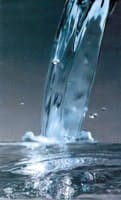"When you can get pure drinking any time just by opening the tap, it’s easy to forget how precious the stuff is," says Brian Pedersen.
He should know. Pedersen, a chemical engineer and senior project manager with local environmental consulting firm BEM Systems, Inc., just returned from nearly a month as a volunteer in Sri Lanka, where he helped set up water-supply systems for some 60,000 Sri Lankan villagers whose drinking water sources had been destroyed or polluted by the killer tsunami of December 26.
With support from employee-owned BEM Systems, Pedersen scrapped winter vacation plans and signed on instead with Water Missions International (WMI), a Charleston, SC-based nonprofit that was preparing to install safe drinking water systems in several areas of Sri Lanka and Indonesia. The company supported his project with over $14,000 in employee donations and corporate matching funds.
"As environmental scientists and engineers, we wanted to help the tsunami victims in a way that would make the best use of our particular abilities and training," explains BEM Systems President Mark Nardolillo. "We knew WMI had developed a sustainable technology—that is, a very effective, appropriate, low-cost water purification system, the Living Water™ Treatment System or LWTS™—specifically for emergency situations like this. Assisting them with specialized professional support looked like our best way to make a significant, long-lasting contribution."
Pedersen’s first stop was Charleston, where he helped WMI’s engineers assemble the water-treatment equipment, produce training manuals, and evaluate modifications to the design based on in-country water quality data. By mid-February he and the WMI team were in Sri Lanka, where the tsunami had ravaged three-quarters of the coastline, killed 31,000 and displaced an estimated half-million people. Their first destination was Kalmunai, on the east coast, one of the hardest-hit towns, with about 3,000 dead.
"The damage was tremendous at Kalmunai," Pedersen says. "About 20,000 people were living in temporary shelters, and most of the wells and freshwater lagoons that constituted their normal water supply had been filled with salt water by the tsunami."
A Canadian Army unit had set up a temporary water purification unit, but was scheduled to leave shortly. By the time the replacement water treatment units arrived in country and reached Kalmunai, the Canadians were only two days away from shutting down. "We found a suitable site on the outskirts of Kalmunai, on a causeway between two canals where there was just enough room to set up the first ten LWTS units in a series," says Pedersen, who also helped instruct local leaders in their use.
After three days’ work the water treatment units were installed and producing 100,000 liters of clean, drinkable water a day, averting any shortage to the local people. "The treated water goes into a set of bladder tanks for storage," Pedersen explained. "Water trucks fill up from our tanks, then they fill smaller tanks throughout the area where the families could come to fill their containers. The LWTS system is just right for this kind of situation, since local personnel can run it easily with just a few hours’ training and the entire system requires only minimal energy and equipment."
The team’s other water supply projects were down the southern coast in the "spectacularly beautiful" Hambantota district, where the December 26 wave had virtually wiped out the two main industries of fishing and tourism, and up the coast near Trincomalee, an area in the northeast controlled by the rebel Tamil Tigers. Pedersen also found an opportunity to independently install a water treatment system for an orphanage near the capital city, Colombo. "People have the idea that Colombo escaped damage, but in fact several low-lying areas were hit. The Dehiwala orphanage serves a coastal area on the outskirts of Colombo, and after the tsunami they suddenly had an extra thousand displaced kids, so they urgently needed an additional freshwater supply."
The Sri Lankans’ resilience and optimism in the aftermath of disaster was impressive and inspiring, Pedersen says. "We met people, especially in the coastal fishing villages, who had lost everything—home, family, livelihood," he says, "but their spirit seems indestructible. Everywhere we worked, we saw these beautiful, smiling faces—especially the children—curious about us, eager to thank us for coming to their country, and ready to get on with the challenge of rebuilding their communities."
According to a United Nations Development Programme report released February 21, clean drinking water will remain a serious concern. Some 62,000 wells in the areas hit by the tsunami are suspected of being contaminated by salt water and/or other pollution, including asbestos from damaged buildings.
As recovery plans start to move forward in the coming months, Pedersen and BEM plan to stay involved with the situation, particularly with respect to the environmental challenges. "These are brave and beautiful people," Pedersen adds, "and it is really a rewarding thing to be helping them start to rebuild their lives."
Source: BEM Systems, Inc.


